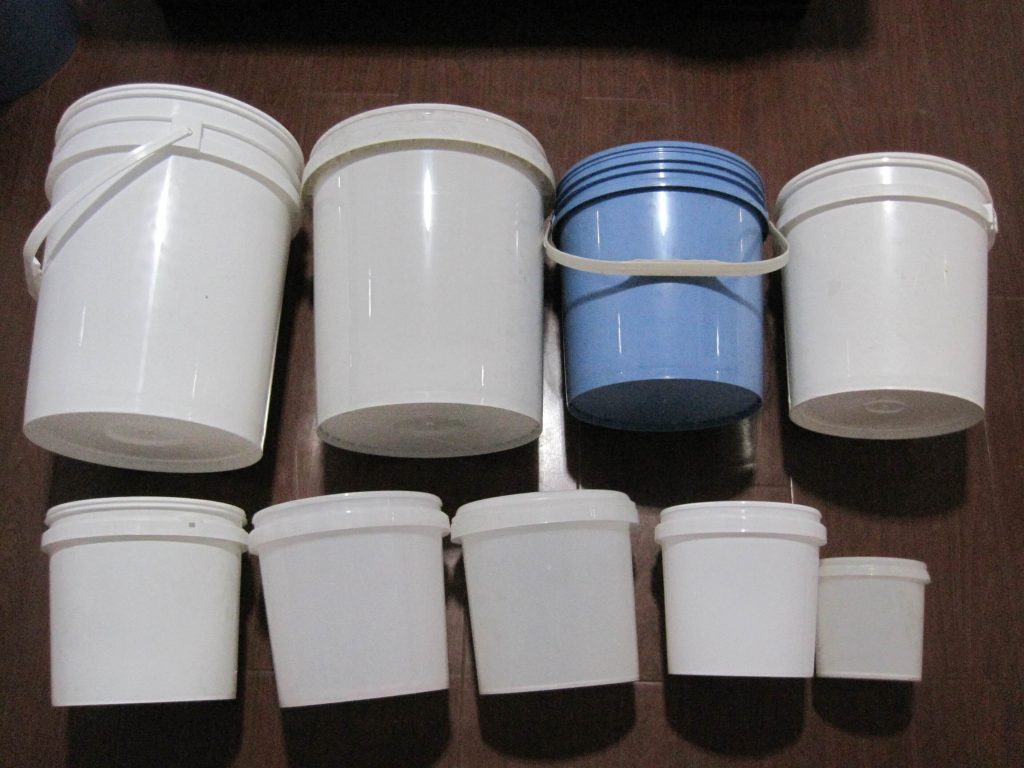Plastic Paint Bucket(pail) Mold, thin wall container mould
A custom Paint Bucket Molds manufacturer, Topworks Plastic Mold Company specializes in thin wall container molds – and is dedicated to providing the best quality plastic molds.
While contributing our ten years of experience and expertise to our customers, we provide them with skilled, knowledgeable, and dedicated employees to manufacture paint bucket(pail) molds.
In addition to providing comprehensive paint bucket mould manufacturing services, Topworks is capable of assembling all sizes of paint buckets (lids, buckets, and handles), and custom assembling stamping and packaging services.
Our team of highly skilled employees designs, manufactures, and supplies any type of plastic mold – whether it is a paint bucket mold or a thin wall container mold.
We offer plastic moulds for plastic paint buckets, thin-wall containers, and paint pails in various sizes, including 0.5, 1L, 3L, 5L, 10L, 18L, 20L, and 25L as well as Beryllium Copper(BeCu) for cooling.
Thin wall injection moulding
Telecommunications and portable electronic devices, which require thinner and lighter plastic housings, have been driving the growth of thin wall injection molding. There are many challenges that Hot Runner suppliers face when dealing with thin walled parts. It is necessary to specify the Hot Runner design and components correctly due to the extreme moulding conditions (high pressures and shear rates).

What is Thin Wall?
A thin wall component (or L/t) is defined based on the ratio between its flow length and wall thickness. Each resin family has its own maximum L/t ratio due to its different flow properties. Here are some examples of maximum L/t ratios for some commonly used materials – figures close to this value would be considered thin walled. As the wall thickness decreases, maximum L/t ratios reduce as well.
| Material | Maximum L/t Ratio |
| ABS | 170-1 |
| SAN | 120-1 |
| POM | 150-1 |
| Polycarboante | 100-1 |
| HDPE | 225-1 |
| LDPE | 275-1 |
| PP | 250-1 |
| PMMA | 130-1 |
| PA | 150-1 |
| PS | 200-1 |
What is thin wall injection molding
“I’m glad to inform you that all plastic parts are perfect!!! We are delighted, and therefore there are good chances to continue our relationship for any coming new project.”

CRISTIANO
ITALY
“Steven is a very detail-oriented project manager and engineer who can solve problems creatively and also provides excellent service. It was a pleasure working with him.”

DAVID
USA
Thin wall injection molding is an advanced and cost-effective manufacturing process that produces plastic parts with very thin walls. The process is used to produce parts in high volume, with a high degree of precision and at a low cost.
Thin wall injection molding produces parts that are less than one millimeter thick in the cross-section (x-axis). This process uses a machine called an injection molding machine that injects molten plastic into a mold cavity. Once the plastic cools, it solidifies and is removed from the mold.
keeping the wall thickness even across the entire part.
The most important requirement of thin wall molding is to keep the wall thickness of the product as evenly as it can across the entire area. This is achieved with a constant flow of material equally distributed across every part of the. This process requires precision equipment to ensure that thin walls are constructed precisely.
To make a high-quality thin wall molding, you must select a tool steel of high-quality that has a great wear resistance. It must also be able of enduring extreme temperatures without losing its form or quality with time.
a number of materials
There are many resin materials that can be used for thin-wall injection molding, including:
Polystyrene (HIPS) – This material is fancy for plastic injection molding parts that require high impact properties.
High Density Polyethylene (HDPE) – This material is great for plastic injection molding parts that require high stiffness and high tensile strength.
Polypropylene (PP) – This material is often used in thin wall applications because it has a low coefficient of friction and good dimensional stability over time.
high speed injection molding machine
A good quality high speed injection molding machine is an absolute necessity tool to produce the thin wall products.
The main reason why thin walled products are very difficult to manufacutre is due to the walls are so thin. The thinner the wall, the less material there is builtin to hold its shape, so it has to be made with more precision machining than usual. A high-speed injection molding machine can handle this task much better than any other type of machine.
High-speed machines operate at speeds of up to 30 feet per second (FPS), which is much faster than other types of machines which run at around 15 FPS. This means that they are able to produce more parts per hour than other types of machines – sometimes even double or triple the amount! They also have a very high cycle time – that is how long it takes from one cycle until another starts again – around 4 seconds on average, which is about twice as fast as standard injection molding machines.
the gate locations and runner design
There are key factors in thin wall injection molding: the gate locations and runner design.
Gate locations: Gate location is determined by many factors such as part material, size and complexity of shape. The closer the gate is to the parting line the smaller will be the part draft angle (see my article on draft angles). This reduces the amount of material needed for a given mold; therefore reducing cycle time and cost. However it also increases stress concentration at that point which may lead to cracks in thin walled parts; especially near corners where stresses are higher (because of bending moment).
Runner design: The runner should be designed so that there are no sharp corners or edges at any point along its length. Sharp corners and edges can cause breakage of runners during ejection from molds leading to increased cycle time due to rework requirements and/or possible damage to molding machines. Part dimensional accuracy is also affected by runner design as it determines how well cooled parts come out of molds without distortion or warping; again leading to rework and/or damage if left unchecked.
Why should you choose thin wall injection moulding
Thin wall injection moulding is the best way to make parts for your product.
Thin wall injection moulding has many advantages over other processes. These advantages include:
Reduced weight
– Thin walled components are lighter than thick walled components. This means that lighter, thinner materials can be used in your products.
Quicker cycle time
– the cycle time for a thin wall injection moulding process can be as low as 4 seconds, which means that you can get your product out of the mould in no time. This not only saves you time but also helps you save money on production costs because of the fast cycle times.
Reduced material costs
– Less material is used with thin walled components, saving you money on expensive raw materials.
Improved quality
– Thin walled components have better surface finish and dimensional accuracy than thick walled parts because there is less material between the tool and the final product.
